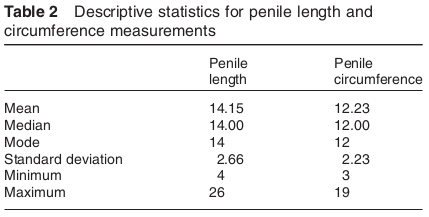A new research study from the Indiana University research team was published online some time ago in the Journal of Sexual Medicine.
Like many studies of penis size, they relied on men to report their penis size.
Then should we be concerned that men would lie about their size? No. Not really.
Dr herbenick answers:
"In fact, unlike most previous studies of self-reported penis size, they
had good reason to report accurate data to us because we were using
their size data to match them to a condom that was sized to fit their
erect penis. If they reported a bigger-than-reality size to us, they
would get a baggier condom. If they reported a smaller-than-reality size
to us, the condom would be too tight."
- Measurement
It was performed using two erect penile measurement tools (one that used a letter-coding measurement system and a second that consisted of a centimeter-based measurement system) and detailed, illustrated directions about how to measure their erect penis, from the underside base and choosing the letter or numerical code that is “closest to the end of the head of your penis,” for the purposes of the study.
You will notice that the measurement is taken from the underside of the penis and therefore, can not be compared to the ususal measurement procedures.
- Results
NB: values are in cm. Divide the value by 2.54 to get the equivalent in inches.
- Discussion
According to these raw results, one should expect that:
- 50% of men have an erect penis girth of less than 12.23cm.
- 84.13% of men have an erect penis girth of less than 14.46cm (mean + one standard deviation).
In fact this is absolutely not the case. Therefore, the standard deviation (2.23 cm) does not provide an accurate percentile rank. The real data give the following repartition:
- 50% of men have an erect penis girth of less than 12cm (this is obvious - the median was given).
- 84.13% of men have an erect penis girth of less than 13.5cm.
- 14.46cm would be at about the 93rd percentile!
The chart below give the detailed distribution:
- Reminder
The direct consequence is that the theoretical bell curve symmetry is broken with more individuals below the mean and grouped in a smaller range while fewer individuals are above the mean and distributed in a wider range.
When graphed, this
type of data looks like a bell that leans to the left.
In a effort to show it, I have gathered few "self-reported" studies, known to be "as serious as possible" scientifically. The collected data may not be as accurate as the one performed in a laboratory, but the phenomenon is more obvious as the number of tested individuals is important and therefore better reflects the broad range of penis sizes.
The selected studies are:
- The current study
- The Kinsey study on penile dimensions
- The Janssen study
- The Lifestyle condoms study performed in Cancun. NB: For this one, the data were collected on the internet with no proof that these are the real results...
I have created a graph which compares these four studies to the few meaningful percentiles used when the curves are normally distributed:
- the 50th percentile (the mean when it is normally distributed, the median otherwise)
- the 15.87th and 84.13rd percentile respectively representing the mean (M) - one standard deviation (SD) and the mean + one standard deviation when the distribution is normal
- the 2.28th and 97.72nd percentile representing the M-2SD and M+2SD when the distribution is normal
- the 99.87th percentile representing the M+3SD (the M-3SD was too small to mean anything) when the distribution is normal.
Graph: Cumulative percentile data of four erect penis circumference studies in cm compared to the usual normal standard deviations percentiles.
- Conclusion
According to the Herbenick study, as many as 15% of the male population has an erect penile girth of more than 13.5cm (5.3in). For this group, a normal sized condom is stretched 30%, which is really uncomfortable (for some, even painful) and accounts greatly for the high fail rate of condom usage.
The same can be said of the 15% of the male population whose erect penis girth is less than 10cm (4in). This group simply can not wear a normal condom without experiencing severe slippage.
Condom producers have a great responsibility in proposing the greatest possible range of condom sizes. Producers like Theyfit, My.Size or Coripa are more than welcome.
Sadly, sometimes, the governments are the cause of the lack of a wide choice. The best example is the US themselves which forbid the condoms to have an opening of more than 54mm (un-stretched circumference of 108mm). Let's hope this will change in the near future, thanks to people like Dr. Herbenick.
Debby Herbenick, Michael Reece, Vanessa Schick, Stephanie A. Sanders. Erect Penile Length and Circumference Dimensions of 1,661 Sexually Active Men in the United States.
The Journal of Sexual Medicine.
Other references:
Our New Research on the Penis Sizes of 1,661 American Men
Psychology today
NB: To receive a copy of the full article from this penis size study, email Dr. Herbenick at cshp (at) indiana (dot) edu.
In the article you will be able to see some very interesting charts like:
In the article you will be able to see some very interesting charts like:
- Participant socio-demographic characteristics by penile length and circumference
- Measurement and erection characteristics by penile length and circumference
- Some discussion on the possible future research.





